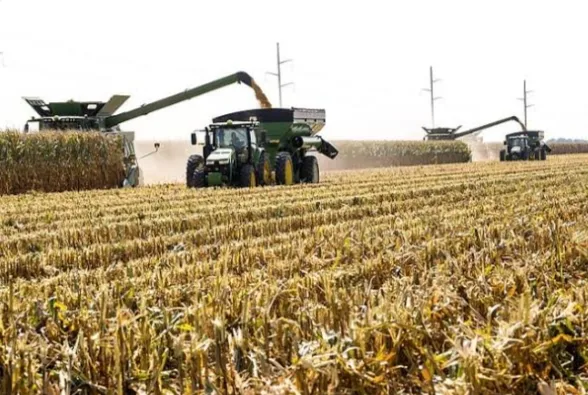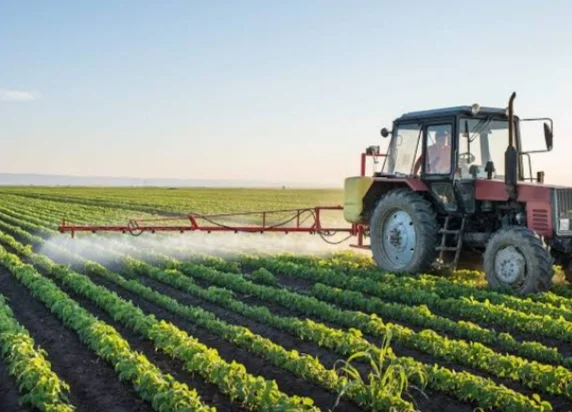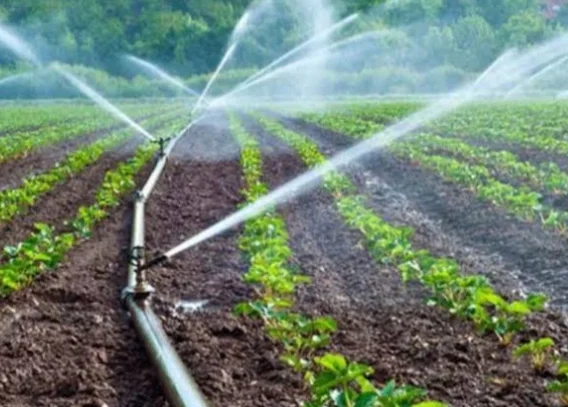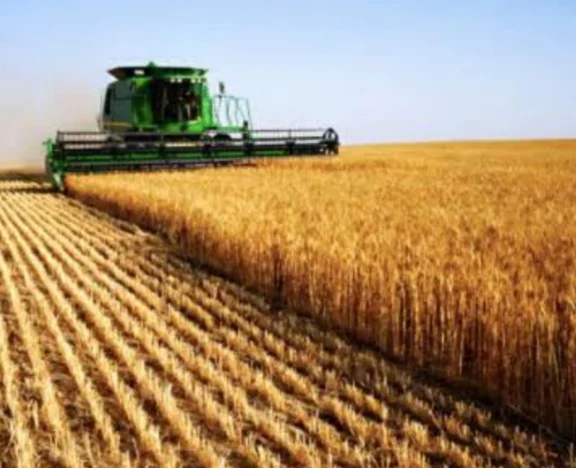▶️ Cultivating Progress: A Look at Modern Agriculture in India
India, a nation deeply rooted in its agricultural traditions, is witnessing a surge in modern farming practices.
This transformation, driven by innovation and necessity, aims to address the challenges of a growing population, climate change, and resource scarcity. Let's delve into the current landscape of modern agriculture in India:
Embracing Technology:
- Precision Agriculture: Data analysis, satellite imagery, and sensors are being used to optimize resource use, track crop health, and improve yields. This data-driven approach minimizes waste and maximizes productivity.
- Drones and Robotics: These tools are revolutionizing tasks like land mapping, crop monitoring, and pesticide spraying. Drones can efficiently survey large areas, while robots automate repetitive tasks, reducing manual labor and increasing efficiency.
- Internet of Things (IoT): Sensors embedded in fields and equipment collect real-time data on soil moisture, temperature, and nutrient levels. This information helps farmers make informed decisions about irrigation, fertilization, and pest control.
Shifting Cultivation Practices:
- Hydroponics and Vertical Farming: These controlled-environment techniques are gaining traction, especially in urban areas. They use less water and land, making them ideal for resource-scarce regions.
- Organic Farming: This approach emphasizes natural methods and reduces reliance on synthetic fertilizers and pesticides. It promotes soil health and produces chemical-free food, attracting health-conscious consumers.
- Mixed Cropping and Intercropping: These practices promote biodiversity and improve soil health by enriching it with nitrogen and reducing pest infestations.
Government Initiatives:
- Digitalization: The government's "Digital Agriculture Mission" aims to provide farmers with access to digital tools and services. This includes e-markets for selling produce, weather forecasts, and expert advice.
- Soil Health Programs: Initiatives like the "Soil Health Card Scheme" provide farmers with soil health reports, enabling them to make informed decisions about nutrient management.
- Financial Support: Schemes like the "PM Kisan Samman Nidhi" provide income support to farmers, helping them adopt modern technologies and improve their livelihoods.
Challenges and Opportunities:
Despite the progress, challenges remain. Unequal access to technology, infrastructure limitations, and knowledge gaps among smallholder farmers hinder widespread adoption. However, the potential of modern agriculture in India is immense. It can improve food security, farmer incomes, and environmental sustainability. By addressing the challenges and harnessing the opportunities, India can pave the way for a more prosperous and sustainable agricultural future.
▶️ Statistical Data on Modern Agriculture in India
Modern agriculture in India is a dynamic field with various initiatives and innovations happening across the country. While there's no single source capturing all aspects, here's a compiled look at some key statistics:
Growth and Productivity:
- Agricultural GDP: Despite employing 43% of the workforce, agriculture contributes only 18% to India's GDP (2022-23 estimate).
- Food Grain Production: India is the world's second-largest producer of food grains, producing an estimated 314 million tonnes in 2022-23.
- Milk Production: India is the world's largest milk producer, generating over 210 million tonnes in 2021-22.
Technology Adoption:
- Internet Users: Only 16% of rural India has access to the internet (2022), impacting digital agriculture reach.
- Soil Health Card Holders: Over 225 million soil health cards have been issued to farmers since 2015.
- Tractor Sales: India leads the world in tractor sales, showcasing mechanization progress.
Sustainable Practices:
- Organic Farming: Organic land area reached 2.75 million hectares in 2020-21, a 26% increase from the previous year.
- Micro-irrigation: Coverage reached 12.28 million hectares in 2021-22, improving water efficiency.
- Renewable Energy in Agriculture: Solar-powered pumps for irrigation are gaining traction, but penetration remains low.
Challenges and Opportunities:
- Land Fragmentation: Average farm size is small (1.16 hectares), hindering economies of scale for modern technologies.
- Climate Change: Erratic rainfall and rising temperatures pose significant risks to crop yields.
- Market Access: Smallholder farmers often face challenges in accessing efficient markets for their produce.
Sources:
- Ministry of Agriculture & Farmers Welfare, Govt. of India: [[invalid URL removed]]([invalid URL removed])
- World Bank: https://data.worldbank.org/
- Food and Agriculture Organization (FAO): https://www.fao.org/
▶️ Statistical Data Table on Modern Agriculture in India (2022-23):
| Indicator | Data | Source |
|---|---|---|
| Agricultural GDP | 18% | Ministry of Agriculture & Farmers Welfare |
| Food Grain Production | 314 million tonnes | Ministry of Agriculture & Farmers Welfare |
| Milk Production | 210 million tonnes | Ministry of Agriculture & Farmers Welfare |
| Rural Internet Users | 16% | World Bank |
| Soil Health Card Holders | 225 million+ | Ministry of Agriculture & Farmers Welfare |
| Tractor Sales (Global Rank) | 1st | World Bank |
| Organic Farming Area | 2.75 million hectares | Ministry of Agriculture & Farmers Welfare |
| Micro-irrigation Coverage | 12.28 million hectares | Ministry of Agriculture & Farmers Welfare |
| Average Farm Size | 1.16 hectares | World Bank |
Additional Notes:
- Data for Agricultural GDP and Food Grain Production is for estimates for 2022-23.
- Milk Production data is for 2021-22.
- Rural Internet Users data is for 2022.
- Soil Health Card Holders data is cumulative since 2015.
- Tractor Sales data is based on 2022 figures.
- Organic Farming Area data is for 2020-21.
- Micro-irrigation Coverage data is for 2021-22.
- Average Farm Size data is from World Bank reports.
Sources:
- Ministry of Agriculture & Farmers Welfare, Govt. of India: http://agricoop.nic.in/
- World Bank: https://data.worldbank.org/
- Food and Agriculture Organization (FAO): https://www.fao.org/
▶️ Thriving with Innovation: Successful Modern Farming Practices in India
1. Precision Agriculture: Data-Driven Decisions for Higher Yields
- Challenge: Inefficient resource use and lack of real-time data lead to suboptimal yields and wasted inputs.
- Solution: Drones, sensors, and satellite imagery collect and analyze field data.
- Impact: Studies show increases in yields (10-30%) and reductions in water and fertilizer use (20-30%).
2. Hydroponics and Vertical Farming: Cultivating Freshness in Urban Areas
- Challenge: Growing populations and shrinking land threaten urban food security.
- Solution:
- Hydroponics: Crops grow in nutrient-rich water solutions, requiring less water and land.
- Vertical farming: Stacked layers maximize production in small spaces with LED lights and controlled environments.
- Impact: Delivers fresh, high-quality produce year-round, reducing reliance on long-distance transport and its environmental footprint.
3. Organic Farming: Nourishing Soil and Consumers
- Challenge: Conventional farming practices rely heavily on chemicals, harming soil health and posing potential health risks.
- Solution: Organic methods use compost, manure, and beneficial insects to control pests and improve soil fertility.
- Impact: Enhances soil health, reduces chemical input, and provides premium produce with higher market prices due to consumer demand.
4. Mixed Cropping and Intercropping: Biodiversity for a Resilient Harvest
- Challenge: Monoculture farming depletes soil nutrients and increases vulnerability to pests and diseases.
- Solution:
- Mixed cropping: Combines different species (e.g., legumes and cereals) in the same field, enriching soil fertility.
- Intercropping: Grows shorter- and taller-maturing crops together, utilizing space efficiently and deterring pests.
- Impact: Enhances biodiversity, improves soil health, and creates a more resilient ecosystem, reducing crop failures and promoting sustainable production.
5. Government Initiatives: Empowering Farmers with Knowledge and Resources
- Challenge: Smallholder farmers often lack access to information, technology, and financial resources.
- Solution: Government initiatives provide access to:
- Digital tools and services: Weather forecasts, market information, and expert advice.
- Soil Health Card Scheme: Personalized soil health reports for informed nutrient management.
- PM Kisan Samman Nidhi: Income support for smallholder farmers to invest in modern technologies.
- Impact: Empowers farmers, improves agricultural practices, and contributes to overall agricultural development.
These are just a few examples. India's agricultural landscape is constantly evolving, embracing new technologies and innovative practices to ensure a brighter future for all.
Frequently Asked Questions about Modern Agriculture in India
1. What are the major challenges faced by modern agriculture in India?
- Land Fragmentation: Small and fragmented landholdings limit the adoption of modern farming practices.
- Water Scarcity: Irrational water use and inadequate irrigation infrastructure contribute to water scarcity.
- Lack of Infrastructure: Poor infrastructure, including roads, storage facilities, and cold chains, hampers value addition and market access.
- Soil Degradation: Overuse of chemical fertilizers and lack of proper soil management practices have led to soil degradation.
- Climate Change: Rising temperatures, erratic rainfall, and extreme weather events pose significant challenges to agriculture.
2. What are some of the key initiatives taken by the Indian government to modernize agriculture?
- Green Revolution: The Green Revolution introduced high-yielding varieties of crops and improved agricultural practices, leading to significant increases in food production.
- Minimum Support Price (MSP): The government provides MSP for certain crops to ensure remunerative prices to farmers.
- Subsidies: The government provides subsidies for fertilizers, seeds, and irrigation to reduce the cost of farming.
- Agricultural Extension Services: The government provides extension services to farmers to disseminate information on modern farming techniques.
- National Food Security Act: The Act provides subsidized food grains to a significant portion of the population, ensuring food security.
3. What is the role of technology in modernizing Indian agriculture?
- Precision Agriculture: The use of technology, such as GPS, GIS, and remote sensing, enables farmers to optimize resource use and improve yields.
- Mechanization: The adoption of agricultural machinery, such as tractors, harvesters, and seeders, can increase efficiency and reduce labor costs.
- Biotechnology: Biotechnology can be used to develop genetically modified crops with improved traits, such as resistance to pests and diseases.
- E-Agriculture: The use of digital platforms can connect farmers to markets, provide information on agricultural practices, and facilitate access to credit.
4. What are the challenges and opportunities in organic farming in India?
- Challenges: Organic farming often requires higher labor inputs, lower yields, and limited market access.
- Opportunities: Organic products have a growing demand in both domestic and international markets, offering a premium price.
5. How can India ensure sustainable agriculture in the future?
- Diversification: Promoting crop diversification can reduce the risk of crop failures and improve soil health.
- Integrated Pest Management (IPM): IPM can help control pests without excessive use of chemical pesticides.
- Water Conservation: Implementing efficient irrigation practices, such as drip irrigation and sprinkler irrigation, can help conserve water.
- Climate-Smart Agriculture: Adopting practices that are resilient to climate change, such as agroforestry and conservation agriculture, can help mitigate the impacts of climate change on agriculture.
- Policy Support: Government policies should promote sustainable agriculture by providing incentives and support to farmers.




